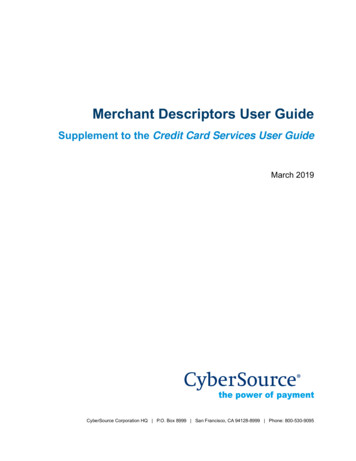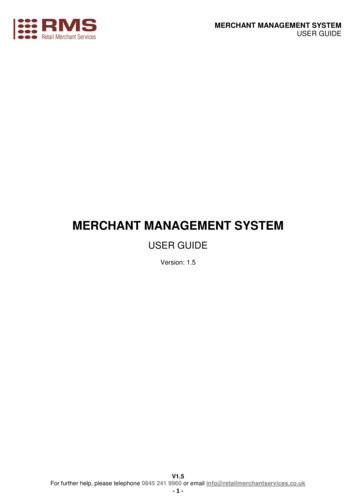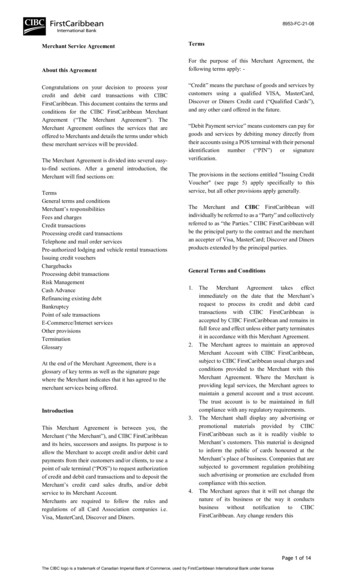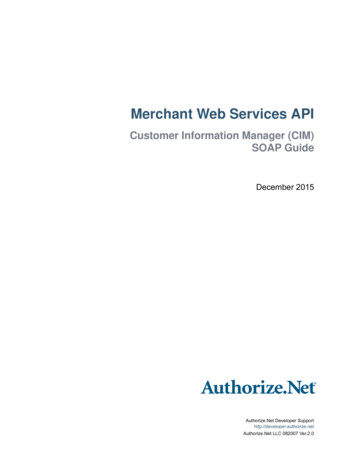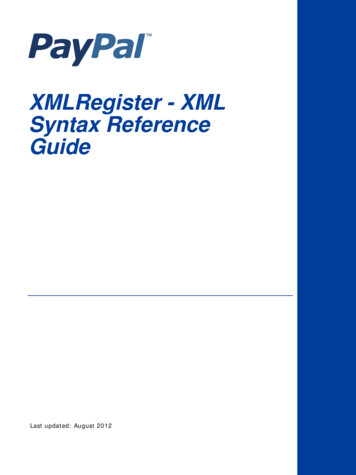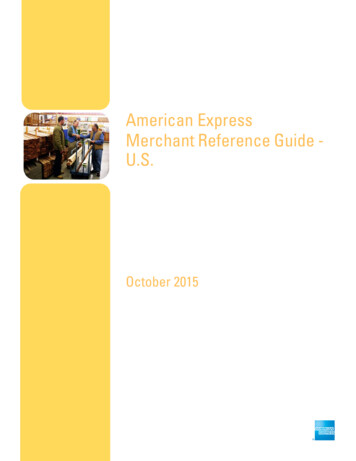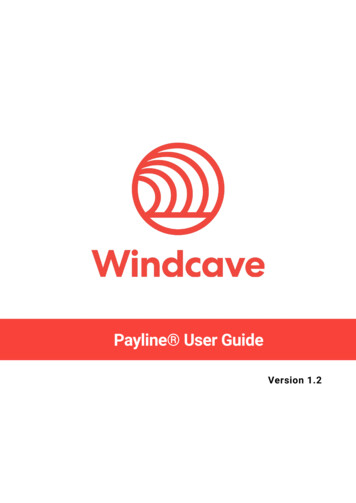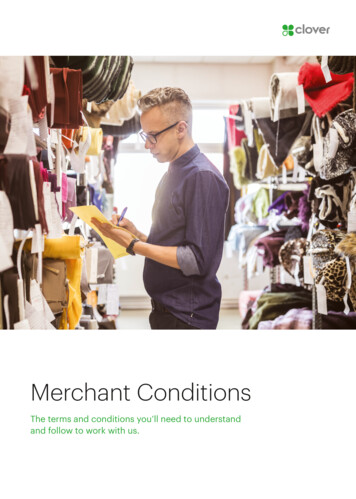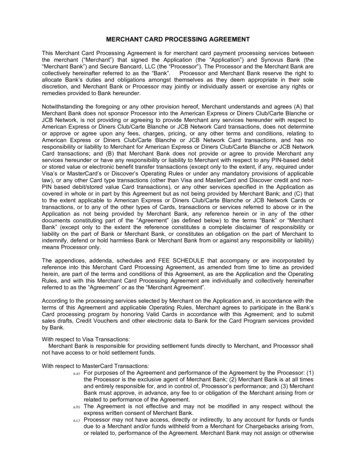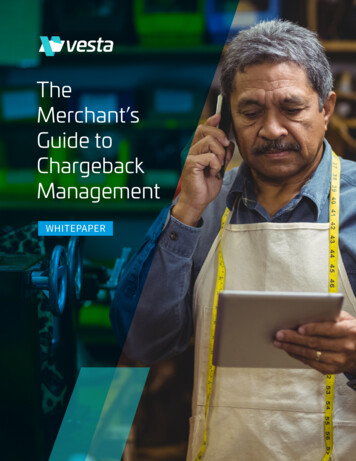
Transcription
TheMerchant’sGuide toChargebackManagementWHITEPAPER
Don’t count your chickens before they hatch.IntroductionTo some extent, chargebacks are like eggs that didnot hatch. You already counted a sale as revenue,only for it to be disputed by the customer, thenreversed by the bank a few days later.A chargeback occurs when cardholders ask theirbanks to reverse a charge. This could be because thetransaction is fraudulent, unauthorized, or due to anunsatisfactory shopping experience with a merchant.If the bank approves the request, it’s forwarded tothe merchant who is legally required to reimbursethe payment.As intended, the ability to request a credit cardcharge be reversed gives shoppers protectionagainst fraud. However, it’s also fertile ground forboth real fraud and friendly fraud to flourish.The most obvious impact of chargebacks onmerchants is revenue loss. However, it cuts muchdeeper, especially considering how competitivethe current ecommerce landscape is. For instance,incurring chargebacks leads to wasted customeracquisition spending.Luckily, merchants are not powerless in the face ofchargebacks. There are several things online retailerscan do to fight this problem. The key is to know howchargebacks work, the best practices to managecosts and how to increase your dispute success rate.vesta.io02
A brief history of chargebacksChargebacks:the basicsThough you likelyunderstand a few basicthings about chargebacks,the information here ismeant to enrich or fill thegaps in your understandingof the history, howthey work and otherfoundational knowledge.1946The first multi-merchant credit card1958The first card with revolving credit1968Creation of the Truth in Lending ActDuring the first half of the 1900s, most ofthe credit cards that were being issued wereproprietary. In 1946, New York banker JohnBiggins created Charg-It Card, the first cardthat was honored in multiple merchants, butonly clients of the Biggins’ Franklin NationalBank were eligible to get one.In 1958, BankAmericard was launched,which was the first credit card with revolvingcredit and could be used at any participatingmerchants. Here’s something interesting.Instead of applying for a card, BankAmericardshipped cards to random people. This createda problem as some of those who receiveda card in the mail didn’t have the financialcapacity to repay the money they owed.In 1968, the Truth in Lending Act (TILA) waspassed to calm fears associated with usingbank cards. The TILA required lenders todisclose credit terms that consumers couldeasily understand.vesta.io03
1974Launch of the Fair Credit Billing Act(FCBA)In 1974, Congress amended the Truth inLending Act which gave birth to the FairCredit Billing Act. This was arguably thefirst law that enabled credit card holdersto dispute charges. The FCBA allowedcardholders to dispute charges that were atleast 50 and met the following conditions: Unauthorized charges The amount charged was incorrect Charges for goods that the customers didnot receive or accept The charge reflects a wrong date Calculation errors The goods were not as describedor damaged1978Enactment of the ElectronicFund Transfer ActThe TILA and the FCBA only covered creditcard holders. In 1978, the Electronic FundTransfer Act was passed to give the sameprotection to debit card holders, althoughits provisions were not as comprehensive asthe FCBA.vesta.io04
The 5 mostcommonreasons forchargebacksOne of the most crucial steps in fightingchargebacks is knowing the reasonswhy customers file for refunds with theirbanks in the first place.Let’s get into the minds of yourcustomers and explore their topmotivations and intentions when theyfile for chargebacks.1“I believe I’ve been the target of fraud.”Fraud is the most legitimate reason forchargebacks and exactly why chargebackrelated laws were created in the first place.30%30% of allchargeback claimsare filed due tounauthorizedtransactions.vesta.io05
2“I didn’t receive my order.”Lost parcels, issues with courier services,stock issues, delays in order preparation—there are a host of reasons for goods notreaching your customers.How do you know whether your customersare telling the truth or just avoiding payingfor some reason? (More on this later).Not receiving anonline order is thesecond most commonreason shoppers filefor chargebacks,accounting for 26%of all claims.326%“This isn’t what I ordered.”If a customer ordered a fitted sheet for aqueen size bed and received one for a kingsize bed, they can (and will) file a chargebackif unable to sort things out on their own withthe merchant.15%This type ofchargebackrepresents 15%of all claims made.vesta.io06
45“Item is not as described.”This is arguably the most disputed, sensitiveand controversial type of chargeback. Whencustomers feel they were deceived intobuying a product, they (understandably)want their money back. This is closely relatedto another common chargeback reason:customers filing for credit charge reversalswhen the items they received didn’t matchtheir expectations. These claims may belegitimate or may be due to unreasonableconsumer behaviors.“I was billed incorrectly.”Incorrect credit card charges can manifest indifferent ways. This could mean getting billedtwice for the same purchase, getting chargedfor shipping when it’s supposed to be free,and other clerical errors.These are just the top overarchingreasons customers file for chargebacks.If you’ve experienced chargebacksbefore, you probably already knowthat there are additional causesrepresented by reason codes. That said,understanding the above-mentionedreasons cover the most common—andmost costly—types of chargebacks thatplague merchants.vesta.io07
An overview of the chargeback processOne major complaint of merchants when it comes to the chargeback process is it’s toocomplicated. In an attempt to simplify things, we created the diagram below.Is the disputevalid?Issuing bank reviewsthe dispute anddecides whether it’valid or not.Customer calls theirissuing bank to filea disuputeYesNoThe issuing bankimmediately issues credit tothe customer and forwards thedispute to the card network.End of thechargeback processNoDoes themerchant disputethe chargeback?YesThe merchant reviewsthe chargeback anddecides whether todispute it or not.The merchant gatherscompelling evidence relatedto the transaction in questionand forwards it to theacquiring bank.The acquiring bankreviews the evidenceand forwardsit to the card network.The card networkpasses the evidenceto the issuing bank forfinal review.The above diagram can have additional steps ifthe cardholder decides to dispute again. If thecardholder opts to do so, the entire processstarts again. This is called pre-arbitration. Ifthe merchant wins the pre-arbitration, thecardholder can dispute again and the issuingbank starts the arbitration process. This willautomatically incur a 250 charge againstthe merchant. The merchant will recoup thisamount if they win the arbitration. However, ifthe merchant loses, it will incur an additionalThe acquiring bankforwards the chargebackto the merchant.Is thecompellingevidencesufficent?NoThe card network facilitiesthe reversal of funds from themerchant’s bank account viaan acquirer. This part of theprocess involves fees that arelater passed on to the merchantYesThe merchant wins and thechargeback is reversed. Thecustomer loses the credit thatwas initially given.The merchant losesand the customerretains the credit. 250 charge or more (some card networksimpose fines from 500 to 900).This is why a number of merchants arehesitant to dispute chargebacks, especiallybecause only 21% of chargeback disputes areruled in favor of ecommerce retailers.That leads to the billion-dollar question(figurative and literal: How can chargebackspotentially cripple your business?vesta.io08
Thefrighteningfacts on howchargebacksimpacte-commercebusinessesThe facts are frightening:Repercussions ofchargebacks in thee-commerce industry arewell documented. They’rewidespread and theyhamper the growth ofhardworking merchants likeyourself. 40BillionA multi-billion dollar problemMerchants are currently losing upwards of 40 billion annually to chargebacks. In manyof these cases, the online retailers were notat fault, but they still shoulder the burdenof lost revenue, unrecoverable goods andchargeback fees for the disputes they lose.These chargeback-related costs force severalmerchants to raise their prices to recoversome of their losses.49%A product of fraud20%Growing at an alarming rate58%Consumers are pulling thetrigger on filing chargebacksAs mentioned earlier, fraud accounts for mostof the chargeback claims filed by shoppers.It’s not surprising that 49% of the revenuemerchants lose due to fraud can be attributedto chargebacks.Chargebacks are bulldozing the e-commercelandscape, and increasing at an alarmingrate. The number of chargebacks onlinemerchants need to deal with is growing by20% annually.It’s time to face somescary statistics:In an ideal world, chargebacks should be thelast resort of consumers. In the case of unmetexpectations, defective goods, and wrongproducts delivered, the customers shouldreach out to the merchants first to sort thingsout. However, 58% of shoppers immediatelycontact their banks to file for a chargeback.vesta.io09
18%Merchants on the losingend of chargeback disputesMerchants are not taking chargebacks lyingdown. In fact, 80% of merchants disputechargebacks they believe are illegitimate.However, only 18% of online retailers arewinning more than 60% of their chargebackdisputes. This means that most of the time,the majority of merchants are losing andare bearing the high costs involved in thechargeback dispute process.71% 45.27Not-so-friendly fraudAmong all chargeback claims filed, 71% arechargeback fraud and friendly fraud. There’sa slight difference between the two. Friendlyfraud involves chargebacks filed because ofhonest mistakes from customers (i.e. theydidn’t recognize a specific legitimate chargeon their credit card). Chargeback fraudinvolves customers trying to use their rightto file chargebacks to avoid paying for goodsthey purchased.Wasted Customer Acquisition SpendThe average cost per acquisition (CAC)or the cost to acquire a new customer inecommerce is 45 This means that aside fromthe revenue and the fees that merchants losedue to chargebacks, the money they spent inacquiring new customers also goes downthe drain.vesta.io010
If chargebacks are left unchecked, you can easilyhemorrhage hard-earned revenue. There are otherrisks associated with chargebacks. For instance, a highchargeback ratio can lead to the cancellation of yourmerchant account. The account preventing you fromaccepting payments from that specific payment channel.This will lead to further customer and revenue loss.The statistics are indeed scary.Fortunately, it’s not all doom and gloom for merchants.In fact, merchants are far from being helpless when itcomes to preventing or minimizing chargebacks.vesta.io011
The 10commandmentsof chargebackmanagement“The worst time to develop a plan is when you geta chargeback. Chargebacks can catch owners bysurprise very often, but then they have a minimalamount of time to respond, so there’s no time tolearn what it is or how to respond.”– Chip RogersPresident and CEO, Asian American Hotel Owners AssociationThe question is not whether chargebacks willhappen, but rather: How strong are the defensesyou put in place to minimize their effects and howprepared are you to mitigate loss if you get hit with achargeback claim?vesta.io012
Vesta’s 10 commandmentsof chargeback managementKnow thyrights as amerchantJust as consumers have rights to filefor chargebacks, the law also affordsmerchants certain rights to protectthemselves from malicious chargebackclaims. These rights include the following: The chargeback amount cannot exceedthe transaction amount Chargebacks cannot be claimedas a chargeback remedy for cashbacktransactions For orders that were delivered late,customers should first attempt to returnthe products to get a refund from themerchant before filing for a chargeback For chargebacks with reason codesrequiring customers to sort thingsout with the merchants first, the issuingbank has the responsibility to verify thata customer has contacted the merchantbefore entertaining a chargeback claim In cases of returned items, theissuing bank should wait 15 daysbefore processing a chargeback to givethe merchant an opportunity to respond A chargeback should be filed within theallowable time period All chargeback process steps should becompleted before moving the dispute topre-arbitration and arbitration All merchants have the right tochargeback representment or to disputechargebacks using all legal meansYou shouldn’t be shy in exercisingthese rights to protect your businessfrom chargebacks, especially if you havecompelling evidence to prove that achargeback was lodged againstyou incorrectly.vesta.io013
Strengthen yourfraud protectionThe equation is quite simple:Low fraud low chargebacks.Of course, this is easier said than done.It takes a strategic mix of good frauddetection and prevention practices andtechnologies to achieve this:2 Choose a secure payment gatewaythat uses a dynamic risksdatabase to increase fraud preventionwhile allowing legitimate orders togo through If available and possible, choosea merchant solution that combinesmerchant processing and settlement,fraud prevention, andchargeback management Use a multi-layered authorization andverification system Use automated fraud detection andprevention tools. Budget permitting,invest in artificial intelligence or machinelearning fraud prevention technology Use manual reviews periodicallyto allow your fraud managersto understand what transactions wereautomatically accepted, declined, andsubmitted for further evaluationIf you win the battle against fraud, you’repreventing the biggest potential source ofchargebacks that might hurt your business.vesta.io014
Thou shallcollect datafor possibledisputes Proof of delivery Signed deliveryreceipts to prove that your customersreceived the goods you shipped Communications log Documentedcommunications between you andyour customers pertaining to thedisputed transaction Address matches Proof of a matchingaddresses bolster your chance thatthe transaction was legitimately made(customer name matches billing address,customer name matches shippingaddress, shipping address matchesbilling address).Data is the biggest ally of merchants indisputing wrongfully filed chargebacksagainst them. The only way to winchargeback disputes is to gather compellingevidence that you held up your end of thebargain. Purchase history If a customerhas purchased an item from you before,especially if the customer has purchaseda similar item involved in the transactionin disputeHere are the important data that you needto collect: Email Should match with the emailprovided by the customer during the timeof the transaction3 Successful payment results Thebilling/shipping address of thetransaction matches the billingaddress of the cardholder in theissuing bank’s records. This also refersto previous transactions made by thesame cardholder using the same identityand card information that didn’t result ina chargeback. Browsing data The transaction wasmade using devices used by thecardholder in other transactionsvesta.io015
4Use a clearpaymentdescriptorMake sure your customers can easilyrecognize that a charge on their creditcard statement came from you. Using yourcompany’s trade name instead of youronline store’s name can create confusionamong shoppers and may flag a legitimatetransaction as fraudulent.vesta.io016
5Provide accurateproductdescriptions“Padding” your product descriptions tomake them more attractive and lure buyersis a surefire way to incur chargebacks.Itcreates unrealistic expectations amongshoppers. This will not only cost you moneyin chargebacks but will also ruin yourreputation.When shoppers read your productdescriptions, they should clearly know whatthey will be getting in the mail. Provide adetailed description, photos, and othervisual aids. If there are discrepancies fromproduct to product because of production,make sure to mention them.vesta.io017
6Ensurethy deliverytimelinesare metTo avoid chargebacks due to latedeliveries, make sure that you have a solidprocurement/production, assembly, andshipping timelines. Employ good stockmanagement practices. Your fulfillmentcenter should be aware of your deliveryschedule. The courier you use should bereliable. In the event that you cannot meetthe agreed delivery date, communicate withthe customers and take the appropriatesteps, before the delivery date arrives.vesta.io
Communicate aclear return andrefund policy7Instead of filing a chargeback with theirbanks, you want your customers to reachout to you and facilitate a refund andreturn for products that did not meettheir expectations. Make sure that yourreturn and refund policies are prominentlydisplayed on all relevant channels such asyour website, social media channels, orderconfirmation emails and receipts.vesta.io019
Provide five-starcustomer service8If your customers feel that it would beeasier to talk to their banks than to sortthings out with you, they will immediatelyfile for a chargeback to get their moneyback instead of using it as a last resort.Excellent customer service is not only anon-negotiable when it comes to customeracquisition and retention. It is also anecessary ingredient for chargebackminimization.vesta.io020
9Invest infraud-relatedchargebackguaranteesInvesting in fraud-related chargebackguarantees is similar to investing ininsurance policies. For instance, Vesta’sPayment Guarantee solution coversfunds for all accepted CNP transactionswith no liability to merchants for fraudrelated chargebacks. Merchants incur zerochargebacks, fines or fees related to thirdparty fraud and unauthorized charges.The reality is at some point, you will behit with fraud-related chargebacks. Thevolume of chargebacks can be higher orlower depending on the season (i.e. peakshopping seasons are often associated withhigher chargebacks). Having a chargebackguarantee minimizes the financial loss onyour end.vesta.io021
Choose thychargebackbattles wiselyWhile we all want to dispute everychargeback that comes our way, we donot recommend fighting all chargebackstooth and nail. Remember, the chargebackprocess favors customers more thanmerchants. Evaluate the situation. Does thechargeback include a minimal amount? Isthe reason behind the chargeback (i.e. lostgoods) difficult to challenge? Do you haveenough compelling evidence to argue yourcase? There will be times when disputinga chargeback will only result in more lostmoney and time. Choose your battlesstrategically.Implementing these 10 strategies doesnot guarantee that your chargebacks willdisappear overnight, nor can it guaranteethat you will have zero chargebacksmoving forward. Realistically speaking, nomerchant is chargeback-proof.That said, implementing these 10chargeback management commandmentsgives you a comprehensive defenseagainst chargebacks. They also ensure thatchargebacks will not make a significantdent on your profitability.vesta.io022
Final words:You’re in chargeWhile chargebacks are not inherentlyevil, using it inappropriately andmaliciously can hurt merchants. It’s anugly truth everyone in the ecommercebusiness has to face, manage andmitigate. And just like any crisis, yourpreparedness to deal with chargebackscan spell the difference between failureand success.Are you looking for a chargebackmitigation and management partneryou can trust? Vesta is here for you.Vesta Corporation is a pioneer inprocessing fully guaranteed Card NotPresent (CNP) payment transactionsfor ecommerce merchants. We offerscalable protection payment solutionsand patented fraud protection services.We focus on protecting your revenuefrom chargebacks and fraud so youcan focus on your company’s strategicgrowth. Our team is ready to help you.Take charge of chargebacks with VestaFind out HowGet in Touchvesta.io023
the merchant. The merchant will recoup this amount if they win the arbitration. However, if the merchant loses, it will incur an additional 250 charge or more (some card networks impose fines from 500 to 900). This is why a number of merchants are hesitant to dispute chargebacks, especially because only 21% of chargeback disputes are


